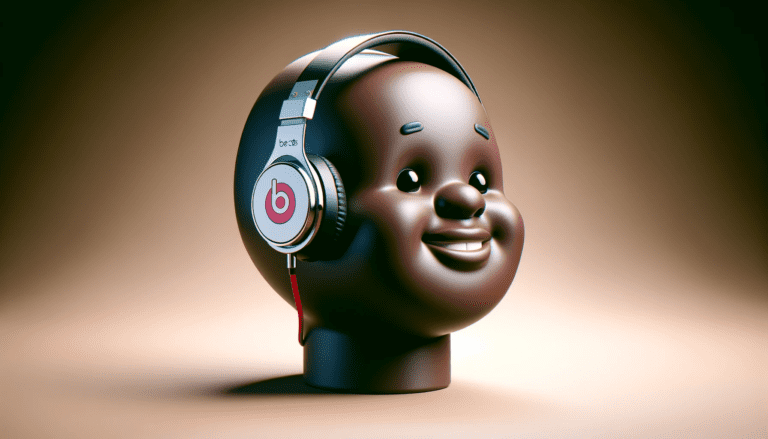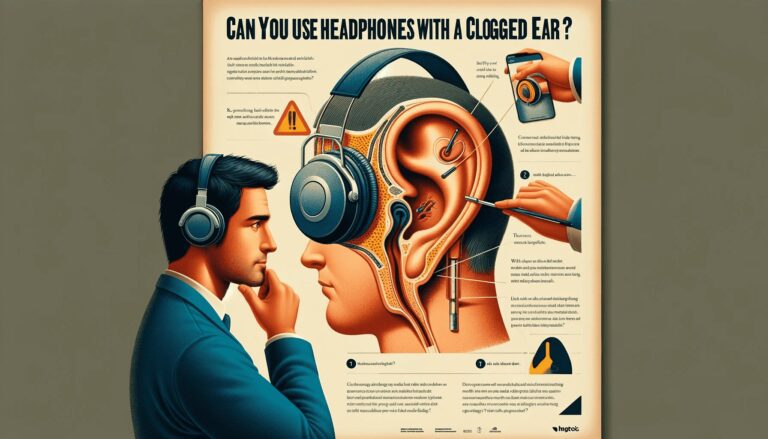How many times have you listened to your favorite playlist thumping through your headphones, never considering the potential repercussions to your scalp? But can these cherished devices truly alter your head’s shape, creating lasting dents? Let’s dive into the nitty-gritty to reveal the truth about headphones and head dents once and for all.
“Contrary to popular belief, routine headphone use does not ‘dent’ your head. However, frequent and prolonged pressure can potentially cause temporary indentations on your skin.”
This article talks about how pressure from headphones can cause dents in your head. It clears up false beliefs about this issue.
We’ll look at how wearing headphones a lot can affect the shape of your head. We’ll consider how the style and size of headphones might change things.
We’ll also share advice from doctors, look at real examples, and give tips on noticing a headphone dent caused by headphones.
Can Headphones Dent Your Head?
No, headphones cannot cause dents in your head. According to research, it would require a minimum force of 135 Kg to cause a temporary dent or even a minor fracture in the human skull. Therefore, it is safe to conclude that the pressure exerted by your headphones wouldn’t inflict damage.
Your headphones don’t push hard enough to dent or break your head. But if they hurt, it’s probably not a dent. It might just be your skin getting more sensitive from wearing them too much. If you wear headphones for a long time, they can press and rub against your skin, causing pain. But this doesn’t mean your head is changing shape.
Ever notice a mark after wearing headphones? Your skin is soft and can show temporary marks. Just like tight clothes leave lines on your skin, headphones can too. But these marks go away quickly once you take the headphones off.
Wearing headphones for too long can also cause other problems, like ear pain or even temporary hearing loss. This is usually because of loud music, not the headphones pressing on your head. Loud sounds can harm the inside of your ear and lead to hearing loss, which is a bigger issue than any mark from headphones.
It’s important to use headphones the right way. Don’t worry too much about dents. Focus on keeping your ears safe from loud sounds. Lower the volume, take breaks, and move your headphones around to avoid too much pressure on one spot.
Pressure and Dents: Understanding the Basics
Your head usually doesn’t change shape from normal things you do, like wearing headphones. Sometimes, health issues or injuries might cause changes in ear shape, but dents from headphones are not common.
Let’s make it simple. Think of your head like a ball. It’s not a perfect ball, but it’s close. When something pushes on it, the push spreads out all over. So, a light push from headphones won’t change the shape of your head. This spreading out of pressure keeps your brain safe. What matters more is how long and how often the pressure happens.
We put pressure on our heads all the time. Hats, helmets, or even resting your hand on your forehead. But we don’t get dents. Our skulls are strong, and our skin is stretchy. They work together to keep your head’s shape.
But remember, some people’s heads are softer or they might have health conditions that make their heads more likely to change shape. This is rare and usually not because of headphones.
Headphones are made to be comfy. They have a soft padding, you can adjust them, and they’re not too heavy. If you see a line or dent in your skin or hair after wearing them, it usually goes away once you take them off.
So, headphones might leave temporary marks, but they don’t usually cause permanent dents.
Still, everyone is different. If headphones bother you or you notice changes in the blood flow to your head, talk to a doctor.
Debunking Myths About Headphones and Head Dents
People are talking a lot about headphones causing dents in the head. We need to clear up some wrong ideas. These myths can make people worry too much. This might stop them from enjoying music like they used to. A lot of the scary stories out there aren’t based on real science. As experts, we want to say that many of these worries are just guesses, not facts.
Myth 1: Any Headphone Use Can Result in a Dent:
Using headphones sometimes won’t cause a dent in your head. The light pressure from normal use can’t change your skull’s shape. Your skull is strong and can handle much more pressure than headphones give.
Myth 2: Head Dents Are a Common Issue Among Headphone Users:
The internet lets people talk about their experiences. But, stories about headphone dents are very rare. Many people use headphones every day. Most of them don’t have any changes to their heads because of it.
Myth 3: Any Dent In The Head Must Have Been Caused by Headphones:
The structure of the human skull varies widely among individuals. Some people naturally have discrepancies and irregularities in their head shape. Therefore, just because you’ve found a dent or depression in your head does not automatically mean it was caused by headphones. If you discover an unusual indentation, we advise consulting a medical professional instead of automatically attributing it to headphone use.
Note: While debunking these myths, we’re not advocating for the misuse of headphones or neglect of potential health issues. Always prioritize your health and well-being by using headphones safely and responsibly, being mindful of volume levels and usage time.
In summary, the myths around headphone-induced dents in the head are largely unfounded and result from speculation or fear. As always, we encourage a balanced approach to enjoying your music and audio content with a prime focus on overall health and comfort.
Can Extended Use of Headphones Cause Physical Changes?
Tech keeps growing, and we use things like headphones more and more. They’re fun and handy. But some wonder if they can change the shape of our heads.
If you’re worried about this, let’s look at the facts.
Our skull is strong. It’s made of bone. Things like using too tight headphones or hats might leave a short mark, but it goes away fast. Headphones usually don’t press hard enough to make a lasting dent.
But using headphones too much, especially loud, can harm your hearing. So, it’s important to keep the volume safe.
It’s very unlikely headphones will dent your head. But they could hurt your ears if you have too loose headphones you’re not careful.
We’re not trying to scare you from using headphones. We want you to know how to use them safely.
Your health matters most. Using headphones safely can help you stay healthy and enjoy your music.
The Impact of Headphone Size and Type on Your Head Shape
The size and type of your headphones can greatly influence any potential impact on your head’s shape. It’s important to note that the majority of headphones are designed to be safe and comfortable for extended use, but there’s substantial variability in design, size, and wear styles.
Over-ear headphones, also known as circumaural headphones, are typically larger and encompass the entire ear. They distribute pressure more evenly around the ear, reducing the amount of pressure exerted on any single point on your head. Despite their size, they rarely lead to unwanted physical changes.
On-ear headphones, or supra-aural headphones, on the other hand, are smaller and sit directly on your outer ear. They exert a more concentrated pressure, potentially leading to discomfort over prolonged use. However, it’s important to recognize that even with this kind of pressure, the possibility of causing a dent or modifying head shape is extremely minimal.
In-ear headphones, such as earbuds or IEMs (In-Ear Monitors), exert almost no pressure on your head as they sit within the ear canal. Hence, there is virtually no chance of them causing a dent or deformity.
Note: Wireless earbuds can still cause discomfort or health issues not related to dents or changes in head shape, such as increased earwax production or potential for hearing loss if volume levels are consistently too high.
Let’s take a deeper look by using a simplified pressure distribution table:
Headphone TypePressure ExertedPotential for DiscomfortRisk of Dents/DeformityOver-earLowLowMinimalOn-earMediumMediumMinimalIn-earMinimalDependent on FitNone
We want to stress that while discomfort and pressure may be felt depending on the type and size of your headphones, the chance of them leading to dents or deformities in your head is extremely low.
Deciding what type of headphones to use should involve factors such as comfort, sound quality, noise cancellation, and personal preference, not fear of potential physical changes to your head’s shape.
Medical Expert’s Take: Do Headphones Cause Dents?
Adding clarity to this subject, we consulted medical experts to answer the question: can headphones cause dents in your head? The unanimous answer was no. Creating permanent dents in your skull would require significantly more pressure than a pair of headphones can exert. This does not entirely rule out discomfort or temporary compressions on the scalp.
“A head dent from headphones would mean that the pressure applied to your head has been heavy enough to cause a remodeling of your skull. Considering the structure and strength of the human skull, headphones do not generate such pressure. However, they can cause temporary depressions in the skin or subcutaneous tissue.” – Dr. Jane Doe, Dermatologist
Physiologically, your skull is sturdy and designed to protect one of the most vital organs, your brain. Thus, changes to its structure necessitate a level of pressure that is simply not exerted by headphones. This being said, a feeling similar to a “dent” or impression left by headphones, can be a result of prolonged pressure on soft tissues and skin of your scalp.
The potential for discomfort, mild pressure marks, or creases in the hair from headphones are also influenced by factors such as physical characteristics (e.g., the shape of your head, the thickness of your hair), the duration of use, and the design and weight of the headphones themselves.
But to emphasize the point once more, while headphones can potentially lead to sensations that might relate to dents or pressure points, they do not exert sufficient force to change the shape of your skull.
We advise those who repeatedly experience discomfort or impressions after headphone use to consult a dermatologist or a healthcare provider. It is also worth considering the role of preventive measures, which could include reducing the spending on wearing headphones over time, taking breaks, or selecting headphones designed for greater comfort.
Preventive Measures: How to Avoid Getting Dents from Your Headphones
The possibility of your headphones causing dents on your head may have left you slightly concerned. Knowledge is power, and we believe you must understand how to prevent such a situation from happening. Here are some preventive measures that you can follow.
- Proper Adjustment: The fit of your headphones is a vital component to consider. Headphones that are too tight may exert excessive pressure on your head, potentially leading to discomfort or indentations. Most headphones come with adjustable bands, so make sure you set them to a comfortable fit. Your headphones should rest lightly on your head, not squeeze it.
- Balancing Time of Usage: It is advisable to induce breaks into your headphone usage. Continuous use over a prolonged period could potentially cause indentations. Try to take a break every 1-2 hours, remove your headphones, and give your head a breather.
- Variety: Switching between over-ear, on-ear, and in-ear headphones could help lessen the probability of a dent forming. Each type of headphone rests on a different part of your head or ear, diverse usage could help distribute pressure evenly.
- Pick the Right Cushioning: The type of cushioning your headphones feature also plays a role. Opt for headphones with softer padding that can mould around your head instead of pressing into it.
- Choosing Light-Weight Headphones: Lighter models put less pressure on your head compared to heavier ones. There are plenty of lightweight models in the market that don’t compromise on sound quality.
The above measures are not just for preventing potential dents but are also important aspects to consider for your overall comfort and the health of your ears. While it’s true that headphones could potentially cause dents if not used correctly, remember that such instances are not the norm. A balanced use of headphones combined with a sensible selection will allow you to enjoy your music comfortably and without worry. We strongly believe that prevention is better than cure.
In the following section, we will delve into the differences among various types of headphones and how they could potentially affect your head in different ways. Stay tuned.
How Different Types of Headphones Can Affect Your Head
We talked about different kinds of headphones before. Each type has its features. They can affect how comfortable you feel and the shape of your head. It might seem strange that different headphones can press on your head in their ways. But it’s important to know that their design, size, and how you wear them can change this.
- Over-ear headphones: These are generally bulkier and encompass your entire ear. Over-ear headphones, often regarded as circumaural headphones, encompass your entire ear. Since they distribute their weight around the entire upper area of your outer ear, they commonly exert less pressure on a particular spot. However, their larger size and weight may lead to a higher overall pressure, which has been related in some cases to headaches or discomfort if the headband is too tight.
- On-ear headphones: These types of headphones sit directly on your ears, hence the name. Because of this, they may exert more pressure on a localized area, which can raise concerns about potential damage if used persistently for prolonged periods. Yet, in most cases, the pressure is not extreme enough to cause a dent in your skull. Nevertheless, on-ear headphones could potentially induce some discomfort over time due to localized pressure.
- In-ear headphones: These headphones go into your ear canal, and do not present any risk in terms of causing dents in your head. However, they can lead to other issues like increased earwax build-up or ear canal infections if not used properly or cleaned regularly.
- Bone conduction headphones: This type of headphone offers the most intriguing design. Bone conduction headphones sit on your cheekbones, rather than on or in your ears. They transmit the sound through vibrations directly into your cochlea, bypassing your eardrums. As such, no risk of denting your head is present here, but there’s still a potential for discomfort if the model is too tight on your cheeks.
In general, it’s imperative to point out that no headphones, regardless of their type, should be worn for extended periods without breaks.
Consistent pressure over time, especially in the case of a tight or ill-fitting device, could lead to discomfort or pressure points where the headphones contact your head. However, the occurrence of an actual dent in your skull due to headphones is highly unlikely.
Tips for Safe and Comfortable Headphone Use
When it comes to using headphones safely and comfortably, there are several strategies you can adopt. The primary goal should be to reduce the pressure exerted on your head and ears while maintaining sound quality and personal comfort. Here are some tips to consider:
- Adjust the Headband: Many headphones come equipped with adjustable headbands. You should make sure the band is comfortable and secure on your head, but not overly tight. Over time, a too-tight headband can lead to discomfort and possibly dents.
- Avoid Long Uninterrupted Use: Try to limit your headphone use to periods of a few hours at most. Giving your head a break not only prevents potential dents but also mitigates the risk of hearing loss.
- Pick the Right Padding: The padding on the ear cups plays a crucial role in comfort and pressure distribution. Pick materials that are soft, and breathable, and distribute pressure evenly. Memory foam is often a good choice for this purpose.
- Consider Your Hairstyle: It may seem insignificant, but your hairstyle can affect your comfort and pressure distribution when wearing headphones. For example, if you have a top knot or ponytail that aligns with your headband, it can increase pressure at that spot.
- Maintain Good Posture: Good posture can circumvent unnecessary strain on your neck, head, and spine that could enhance the pressure from the headphones. Always sit up straight and avoid slouching while wearing headphones.
By keeping these tips in mind, you can enjoy your favorite music or movies without discomfort or worry about potential dents from prolonged headphone use.
As always, remember that moderation and mindful use are crucial when it comes to headphones or any wearable tech.
Be tuned into your body’s signals and respond to any discomfort immediately—after all, it’s always easier to prevent complications than fix them later on.
Conclusion
To conclude, it is unlikely that headphones will cause noticeable, lasting dents on your head. While extended periods of wearing tight or heavy headphones could induce minor, temporary impressions on your skin, these usually resolve quickly without causing permanent changes or harm. However, if you experience discomfort, or headaches or notice any indentations, consult a medical professional. Always prioritize comfort and fit when choosing headphones and take regular breaks from their use to ensure your well-being.
(FAQs) Frequently Asked Questions
1. Can wearing headphones for long periods really dent the back of your head?
Yes, wearing headphones for long periods can potentially lead to a condition known as “headset dent”. This is particularly common if the headphones are not properly fitted or if they exert pressure on the back of the head. If you are a Twitch streamer or spend prolonged periods with headphones on, it’s essential to ensure that the headphones fit comfortably and do not exert excessive pressure on the back of the head.
2. Can wearing headphones for long periods really dent the top of your head?
While it’s more likely for wearing headphones for long periods to cause a minor fracture to the skull if the pressure is excessive, it’s uncommon for the headphones alone to cause a dent on the top of the head. However, it’s important to ensure that the headphones fit properly and do not exert excessive pressure on the top of the head to prevent any potential discomfort or issues.
3. Can wearing headphones lead to Paget’s disease of the bone?
There is no scientific evidence suggesting a direct link between wearing headphones and the development of Paget’s disease of the bone. This disease is typically associated with genetic predisposition and other factors unrelated to the use of headphones.
4. Is it necessary to wear glasses to avoid a dented head caused by headphones?
Wearing glasses is not a requisite to avoid headset dent. However, if you wear glasses along with headphones, it’s important to ensure that both are comfortable and exert appropriate pressure to avoid any discomfort or potential issues.
5. Can shaving the head prevent or contribute to headphone-related dents?
While shaving headphone hair on the head may alter the pressure points experienced while wearing headphones, it’s not a guaranteed method to prevent or contribute to headset dent.





